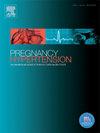First trimester preeclampsia screening and risk of placental lesions
IF 2.9
4区 医学
Q2 OBSTETRICS & GYNECOLOGY
Pregnancy Hypertension-An International Journal of Womens Cardiovascular Health
Pub Date : 2025-07-03
DOI:10.1016/j.preghy.2025.101236
引用次数: 0
Abstract
Objectives
The purpose of our study was evaluate differences in placental histopathology basing on first trimester preeclampsia screening.
Study Design
Observational case-control study; monocentric enrolment at first trimester ultrasound at the department of Obstetrics and Gynecology of IRCCS Policlinico San Matteo; 278 placental specimen from 234 non-preeclamptic women and 44 preeclamptic women; histopathological examination and evaluation basing on first trimester preeclampsia multiparametric screening; continuous variables were compared by Kruskal-Wallis analysis of variance, categorical variables were compared by Fisher exact test or chi-square test.
Main outcome measures
Placental lesions prevalence according to first trimester screening result.
Results
preeclamptic screen-positive patients had higher frequency of adverse pregnancy outcomes and higher frequency of placental MVM lesions. Screen-positive patients who do not developed preeclampsia had poor maternal and fetal outcomes and higher prevalence of MVM, FVM and placental chronic inflammatory lesions.
Conclusions
Our results shows that the screening identifies pregnancies with placental lesions, which, irrespectively of the development of preeclampsia, correlate with impaired fetal growth and poor pregnancy outcomes. The presence of MVM, FVM and VUE in patients at high risk for preeclampsia reflects the need for close clinical follow-up during pregnancy due to the increased risk of adverse outcomes.
妊娠早期子痫前期筛查与胎盘病变风险
目的探讨基于早期子痫前期筛查的胎盘组织病理学差异。研究设计:观察性病例对照研究;圣马特奥icccs Policlinico妇产科学中心孕早期超声单中心登记;来自234名非子痫前期妇女和44名子痫前期妇女的278份胎盘标本;基于早期子痫前期多参数筛查的组织病理学检查与评价连续变量比较采用Kruskal-Wallis方差分析,分类变量比较采用Fisher精确检验或卡方检验。主要观察指标:根据妊娠早期筛查结果,胎盘病变发生率。结果子痫前期筛查阳性患者不良妊娠结局发生率高,胎盘MVM病变发生率高。未发生子痫前期的筛查阳性患者的母胎结局较差,MVM、FVM和胎盘慢性炎性病变的患病率较高。结论胎盘病变与子痫前期的发展无关,与胎儿生长受损和妊娠结局不良相关。高危子痫前期患者存在MVM、FVM和VUE反映了由于不良结局风险增加,妊娠期间需要密切的临床随访。
本文章由计算机程序翻译,如有差异,请以英文原文为准。
求助全文
约1分钟内获得全文
求助全文
来源期刊

Pregnancy Hypertension-An International Journal of Womens Cardiovascular Health
OBSTETRICS & GYNECOLOGYPERIPHERAL VASCULAR-PERIPHERAL VASCULAR DISEASE
CiteScore
4.90
自引率
0.00%
发文量
127
期刊介绍:
Pregnancy Hypertension: An International Journal of Women''s Cardiovascular Health aims to stimulate research in the field of hypertension in pregnancy, disseminate the useful results of such research, and advance education in the field.
We publish articles pertaining to human and animal blood pressure during gestation, hypertension during gestation including physiology of circulatory control, pathophysiology, methodology, therapy or any other material relevant to the relationship between elevated blood pressure and pregnancy. The subtitle reflects the wider aspects of studying hypertension in pregnancy thus we also publish articles on in utero programming, nutrition, long term effects of hypertension in pregnancy on cardiovascular health and other research that helps our understanding of the etiology or consequences of hypertension in pregnancy. Case reports are not published unless of exceptional/outstanding importance to the field.
 求助内容:
求助内容: 应助结果提醒方式:
应助结果提醒方式:


